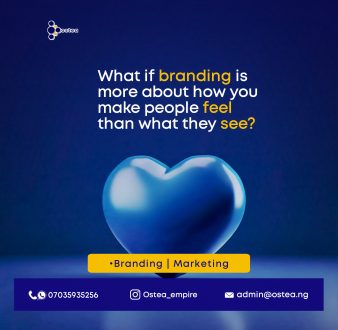
Picture this: You’re hungry, and the perfect meal—your favorite—is within reach. But instead of eagerly purchasing it, you walk away, even with your stomach growling. This was exactly what happened to a friend of mine. We were out one afternoon, and my friend, who had been craving a specific dish, approached a vendor known for serving that exact meal. However, despite his hunger and fondness for the food, he refused to buy from her.
Surprised, I asked, “Why didn’t you buy it? It’s your favorite dish, and you’re hungry.
What’s the problem?” He turned to me and said, “I’ve bought from her a couple of times, but the food quality wasn’t good. I won’t keep buying what I don’t enjoy.”
In that instant, the vendor lost not just my friend as a customer, but also me. And it wasn’t
because of a bad logo, poor marketing, or an unattractive design. She lost us because of the
product itself—the food didn’t live up to our expectations.
This story perfectly encapsulates a vital aspect of branding: your image doesn’t end with
beautiful designs or catchy slogans. A well-crafted logo might draw people in, but it is the
experience that keeps them coming back or drives them away.
When we think of branding, we often think of it in terms of aesthetics—the logo, color scheme,
and website design. But branding goes beyond these surface-level elements. It is, at its core,
the promise you make to your customers and the experience they have with your product or
service. In the case of the food vendor, her “brand” was no longer her tasty dishes, but her
inconsistency and poor quality. That perception became her brand.
Your brand is the sum of how your audience perceives your business. It’s what they think,
feel, and say about your brand when you’re not around. Every interaction your customers have
with your business, whether positive or negative, contributes to this perception.
In the story above, the vendor’s brand went from being associated with tasty food to something
less desirable. Why? Because the product did not consistently meet expectations. Similarly,
your brand’s logo may serve as a visual identifier, but the true meaning behind it comes from the
overall experience your audience has with your product or service. This is what they remember
when they see your logo.
Think about it: When that carefully designed logo you spent hours creating pops up in the mind
of your audience, what will they associate with it? Will it be a feeling of trust and satisfaction? Or
will it be frustration and disappointment?
The reality is that the interpretation of your logo goes beyond its visual appeal—it’s deeply tied
to the customer’s experience with your brand.
While creating a beautiful logo and a stunning website is important, it’s crucial to remember that
branding doesn’t stop there. In fact, that’s just the beginning. What truly shapes your brand is
the experience your clients have each time they interact with your business. This includes:
As a business owner or startup founder, you need to view branding holistically. Don’t focus all
your energy on visual design while neglecting the experience you’re offering. Branding is a
combination of the tangible and intangible—the visual elements people see and the emotions
they feel when they think of your business.
Remember, just like the food vendor in the story, your brand is not just what you sell, but how
well you deliver on your promises. Every client interaction is an opportunity to either strengthen
or weaken your brand perception.
So, the next time you think about your logo, think about what it stands for. Is it just a pretty
design, or does it represent an experience that keeps customers coming back for more?
Ultimately, branding is about much more than colors, fonts, and designs. It’s about how well you
connect with your customers and deliver value to them. When done right, your brand becomes
something more than just a logo—it becomes a lasting impression, a promise kept, and a
relationship built.
So, keep branding, not just with visuals, but with every action you take as a business.